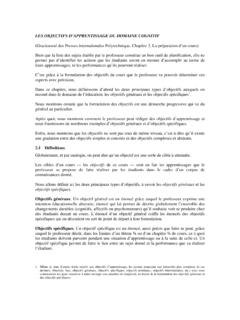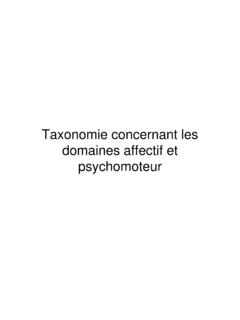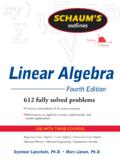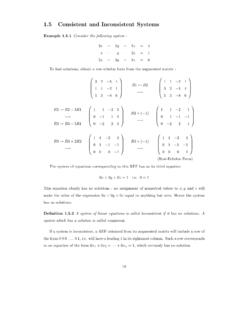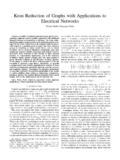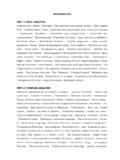Transcription of Basic Concepts in Data Reconciliation Module: …
1 Basic Concepts in Data Reconciliation Module: Introduction to Data Reconciliation Program for North American Mobility in Higher Education Introducing Process Integration for Environmental Control in Engineering Curricula North Carolina State University, USA University of Ottawa, Canada, 2003. Basic Concepts in Data Reconciliation Objective of this Module: This module introduces Concepts of data Reconciliation techniques that have been widely used in processing industries. Some examples are presented throughout the text, so that an audience can easily understand the data Reconciliation algorithms. After completing this module, an audience should be able to solve practical problems encountered in reconciling process data, either by their coded MATLAB programs, or commercial software.
2 North Carolina State University, USA University of Ottawa, Canada, 2003. Basic Concepts in Data Reconciliation Structure of This Module This module consists of three tiers: Tier I Basic Concepts in Data Reconciliation Tier II Case Studies Tier III Open-Ended Problem Each tier is ideally completed in order. Some practical examples and quizzes are presented throughout the module to better gasp the various Concepts . For each quiz, there are one or more than one correct answers. North Carolina State University, USA University of Ottawa, Canada, 2003. Basic Concepts in Data Reconciliation Tier 1: Basic Concepts in Data Reconciliation North Carolina State University, USA University of Ottawa, Canada, 2003. Basic Concepts in Data Reconciliation Table of Contents CHAPTER 1 General Introduction Process Measurements Measurement Error Data Reconciliation Process Variable Classification Redundancy Quiz Suggested Readings CHAPTER 2 Linear Steady-State Data Reconciliation with All Variables Measured Solution to Reconciled Values Statistical Properties of Reconciled Values Quiz Suggested Readings North Carolina State University, USA University of Ottawa, Canada, 2003.
3 Basic Concepts in Data Reconciliation Table of Contents (cont'd). CHAPTER 3 Linear Steady-State Data Reconciliation with Both Measured and Unmeasured Variables Solutions to Estimates of Measured Variables Solutions to Estimates of Unmeasured Variables Observability and Redundancy Analysis Quiz Suggested readings CHAPTER 4 Steady-State Data Reconciliation for Bilinear Systems Bilinear System Solution to Bilinear Data Reconciliation Quiz Suggested readings CHAPTER 5 Steady-State Nonlinear Data Reconciliation Formulation of Nonlinear Steady-State Data Reconciliation Successive Linearization North Carolina State University, USA University of Ottawa, Canada, 2003. Basic Concepts in Data Reconciliation Table of Contents (cont'd). Nonlinear Solution Quiz Suggested readings CHAPTER 6 Steady-State Data Reconciliation with Model Uncertainties Models with Uncertainties Data Reconciliation Algorithm with Uncertain Models Solutions to Data Reconciliation with Uncertain Models Quiz Suggested readings CHAPTER 7 Dynamic Data Reconciliation Formulation of Dynamic Data Reconciliation Linear Dynamic Data Reconciliation Dynamic Data Reconciliation with Kalman Filter linear Dynamic Data Reconciliation Quiz North Carolina State University, USA University of Ottawa, Canada, 2003.
4 Basic Concepts in Data Reconciliation Table of Contents (cont'd). Suggested readings CHAPTER 8 Gross Error Detection Global Test Serial Elimination The Combined Procedure Estimation of Gross Error Magnitude Quiz Suggested readings North Carolina State University, USA University of Ottawa, Canada, 2003. Basic Concepts in Data Reconciliation Chapter 1: General Introduction North Carolina State University, USA University of Ottawa, Canada, 2003. Basic Concepts in Data Reconciliation Process Measurements CHAPTER 1. Measured process data inevitably contain some inaccurate General information, since measurements are obtained with imperfect Introduction instruments which have their own accuracy. In addition, signal transmission, power fluctuation, improper instrument installation and miscalibration are other sources of measurement errors.
5 It is assumed that any observation is composed of a true value plus some error value. This indicates that a measurement can be modeled as: y=x+e ( ). where y is the observed value of the raw measurement, x is the true value of the process variable, and e is the measurement error. North Carolina State University, USA University of Ottawa, Canada, 2003. Basic Concepts in Data Reconciliation Measurement Error CHAPTER 1. The error term in Equation ( ), e, can be divided into two General subcomponents, random error and gross error, as shown in Introduction Figure y=x+e Two Components: Random Error, . Random Error, Gross Gross Error, Error, eess y = x + es+ . Figure : Components of measurement errors North Carolina State University, USA University of Ottawa, Canada, 2003.
6 Basic Concepts in Data Reconciliation Measurement Error CHAPTER 1. Random error is caused by one or more factors that randomly General affect measurement of a variable. It follows a Gaussian Introduction distribution. Gaussian distribution Figure : Typical measurement errors as Gaussian noise North Carolina State University, USA University of Ottawa, Canada, 2003. Basic Concepts in Data Reconciliation Measurement Error CHAPTER 1. The Gaussian noise is normally distributed with a mean value General of zero and known variance. The probability density function Introduction (PDF) of a measurement with Gaussian noise is described by the formula: (y- ) . 2. 1. P(y) = exp ( ). 2 2 . 2. where is the mean value of the measurements, and is the standard deviation.
7 The important property of random error is that it adds variability to the data, but it does not affect average performance for the group. North Carolina State University, USA University of Ottawa, Canada, 2003. Basic Concepts in Data Reconciliation Measurement Error CHAPTER 1. Gross error (as depicted in Figure ) can be caused by: General Introduction instrument systematic bias that is consistently erroneous, either higher or lower than the true value of the process variable, probably because of instrument miscalibration measurement device failure nonrandom events affecting process, such as process leak. 8. 4. Gross error 0. -4 Measurements True -8. 0 20 40 60 80 100. Time Figure : Gross error in measurements North Carolina State University, USA University of Ottawa, Canada, 2003.
8 Basic Concepts in Data Reconciliation Measurement Error CHAPTER 1. Unlike random errors, gross errors tend to be consistently General either positive or negative. Because of this, it is sometimes Introduction considered to be a bias in the measurement. Generally, measurements with gross errors will lead to severely incorrect information about the process, much more so than those with random errors. Gross error detection is an important aspect in validation of process data, and will be discussed further in Chapter 8. North Carolina State University, USA University of Ottawa, Canada, 2003. Basic Concepts in Data Reconciliation Measurement Error CHAPTER 1. Errors in measured data can lead to significant deterioration in General plant operation. Small random and gross errors deteriorate Introduction the performance of control systems, whereas larger gross errors can nullify process optimization.
9 It is important to estimate the true conditions of process states with the information provided by the raw measurements, in order to achieve optimal process monitoring, control, and optimization. Estimator or Filter Measurements Estimates Data bus Data bus North Carolina State University, USA University of Ottawa, Canada, 2003. Basic Concepts in Data Reconciliation Data Reconciliation CHAPTER 1. The estimation of a process state involves the processing of General the raw data and their transformation into reliable information. Introduction For example, Plant 1 Plant 3 Plant 4. CWS: Cooling FI FI FI FI. Water Supply CWS CWR. 1 3 5 6. CWR: Cooling FI FI. Water Return 2 4. Plant 2. Figure : A cooling-water circulation network North Carolina State University, USA University of Ottawa, Canada, 2003.
10 Basic Concepts in Data Reconciliation Data Reconciliation CHAPTER 1. a cooling-water station provides water for four plants as shown in General Figure All the flow rates for the circulation water are Introduction measured in this network. At steady-state, the raw measurements and their standard deviations are listed in Table Table : Flow measurements in cooling water network Stream Raw Standard No. Measurement Deviation, . Plant 1 Plant 3 Plant 4 (kt/h) (kt/h). FI FI FI FI 1 CWS CWR 2 1 3 5 6. 3 FI FI. 4 2 Plant 2 4 5 Figure 6 North Carolina State University, USA University of Ottawa, Canada, 2003. Basic Concepts in Data Reconciliation Data Reconciliation CHAPTER 1. If we make mass balances around each plant in the network General using the raw measurements, we will find that all the flow Introduction measurements contain errors.
